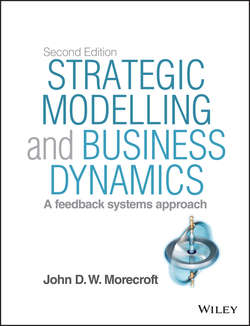Читать книгу Strategic Modelling and Business Dynamics - Morecroft John D. - Страница 10
На сайте Литреса книга снята с продажи.
Preface from the First Edition 3
Bounded Rationality and Behavioural Decision Making
ОглавлениеMy thesis showed that sparse and ‘simple’ information networks in firms can often deliver business performance that is superior to more complex and sophisticated information networks. This observation led me, as a newly-appointed junior faculty member at MIT Sloan, into the literature of the Carnegie School and Herbert Simon's work on bounded rationality. The idea that the ‘structure’ of a firm's information feedback network determines the firm's performance and dynamic behaviour is central to system dynamics.4 The Carnegie literature helps to bring the information network into clear focus and to explain why human decision makers, faced with complexity and information overload, prefer sparse information networks. People and organisations are boundedly rational. They cannot gather or process all the information needed to make ‘best’ (objectively rational) decisions. Whenever people take decisions that lead to action, they selectively filter information sources, disregarding or overlooking many signals while paying attention to only a few. Well-designed policies recognise this human trait, while functional ‘stovepipes’ are an unfortunate corollary that stem from poor design (or no design at all). In practice, bounded rationality leads to departmentalised organisations in which the left hand quite literally doesn't know (and shouldn't need to know) what the right hand is doing. Loose coordination among functions, departments or sectors is normal.
Bounded rationality helped me to identify, interpret and better understand information feedback loops in business and social systems. Puzzling dynamics nearly always arise from ‘hidden’ coordination problems and this idea is woven throughout the book, beginning with the simple fisheries model in Chapter 1, continuing in Chapter 4's world of showers and in Chapter 5's factory model, and culminating in Chapter 7's market growth model. The information/coordination theme continues in Chapter 8 (the oil industry), in part of Chapter 9 (a return to fisheries) and in Chapter 10 (product growth dynamics in fast-moving consumer goods).
I was not alone at MIT in working on bounded rationality and system dynamics. John Sterman too was studying the topic, and using it to make sense of long-term economic cycles generated by the National Economic Model. Through conversations, seminars and papers I gained a better appreciation of the information processing assumptions of system dynamics that distinguish the subject from traditional micro-economics on the one hand and optimisation methods in management science on the other.
4
See also a guest lecture I delivered at WPI in 2009 entitled ‘Reflections on System Dynamics and Strategy’. It can be found on the Learners' website in a folder entitled ‘A Glimpse of Learning Phases in the Preface’. The same lecture can also be viewed on YouTube by searching under ‘System Dynamics and Strategy’.
